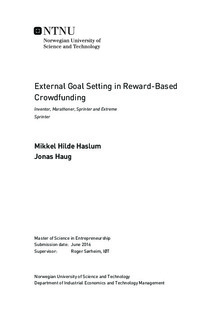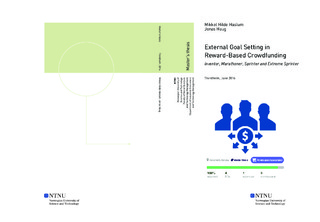| dc.description.abstract | Purpose In recent years, crowdfunding has emerged as a popular method to finance entrepreneurial ventures. Entrepreneurs appeal directly to the general public, e.g. the crowd, for help getting their innovative ideas off the ground.
Within the world of reward-based crowdfunding, the authors of how to -literature (practitioners) and the authors of theoretical reward-based crowdfunding literature (theoreticians) disagree on strategies for setting the external (i.e. public) funding goal. Theoreticians state that potential backers are less likely to contribute once a project reaches its goal and that crowdfunding projects fail by large amounts and succeed by small, while practitioners state that reaching the funding goal as fast as possible, to be seen as a success and to more securely pre-sell your product, generates success.
Research on the field has been very limited, and is also quickly outdated, as the world of reward-based crowdfunding is fast evolving. This study targets the contradicting statements of theoreticians and practitioners and uses a new approach to shed light on the topic of funding goal setting within reward-based crowdfunding, with the goal of providing valuable insights that could help entrepreneurial ventures raise capital through reward-based crowdfunding.
Theory It is agreed that projects with lower external goals are more likely to reach that external goal. Some researchers argue that potential backers are less likely to contribute once a project reaches its goal, explaining this with crowding out and the goal gradient hypothesis. Thus recommending reaching the external goal at the end of your campaign.
Others claim that one should hit the external goal as fast as possible, and that reaching the goal fast brings more practical advantages than theoretical disadvantages.
After a thorough literature review we provide a definition of private good-type of RBCF projects, and suggest focusing research on these types of projects to shed light on the conflicting findings in current theory.
Private good-type project:
A reward-based crowdfunding project that involves pre-selling of a consumer product. There must be a physical product that is manufactured and delivered to each individual backer.
Research questions We focus our research on the contradicting views on external goal setting within the field of crowdfunding. With the aim of developing a better understanding of how external goals are set in private good type projects, we ask the following research questions:
RQA:
How do private good-type crowdfunding projects set external goals?
RQ1: Are there external goals that are substantially lower than internal goals?
RQ2: How are external goals determined?
RQ3: What are the founders reasons for setting the external goal lower than the internal goal?
RQ4: Based on their external goal setting approach, how can private good-type crowdfunding projects be grouped and what are the common traits within each group?
Methodology/approach - The thesis is based on ten case studies of successfully launched projects within the Product Design subcategory on Kickstarter (KS). Semi-structured interviews were conducted with the founders using Skype. The multiple case study is confirmatory, in the sense that earlier theories are reviewed, and at the same time inductive due to unexpected findings that has not previously been explained in existing literature.
Findings Our findings from the in-depth interviews with the ten founders, related to the research questions, are summarized below:
1. Founders set their external goals lower than their internal goals.
2. Founders use a bottom-up or top-down approach when determining their external goal.
3. Reasons for setting the external goal lower than the internal is either related to founders playing it safe or a strategy to get funded fast. There are four main reasons why getting funded fast is good:
a. KS exposure
b. Media attention
c. Internal motivation
d. Promoting backer consumerism
4. Looking at goal setting the founders can be grouped based on their mindset and approach to KS:
a. Inventor
b. Marathoner
c. Sprinter
d. Extreme Sprinter
In addition, we had an unexpected finding on a recent transition of Kickstarter as a platform for inventor type projects to an established retail marketplace with its own customer base and following. This might indicate a shift in reward-based crowdfunding, towards consumerism and traditional sales and marketing theory.
Originality/value - We contribute to crowdfunding theory by acknowledging and defining external and internal goals, explaining founders reasoning in external goal setting, our categorization of founders based on their attributes, the provision of a founder s perspective in the reward-based crowdfunding space, the explicit acknowledgement of Kickstarter as an online marketplace and the definition of private good-type projects.
We disprove theories stating that potential backers are less likely to contribute once a project reaches its goal (Kuppuswamy and Bayus, 2013), proving the opposite, for a subsample on the same crowdfunding platform they used as data sample, Kickstarter. Thus implying that future research should consider constraining and narrowing their scope when studying reward-based crowdfunding.
In addition, our research can help entrepreneurial ventures set the correct external funding goal, and strategize accordingly, to increase their funding amounts and chances of success.
Keywords CF, RBCF, Crowdfunding, reward-based crowdfunding, goal setting strategies, funding goal, internal goal, external goal, private good-type project, Kickstarter, Inventor, Marathoner, Sprinter, Extreme Sprinter. | |

